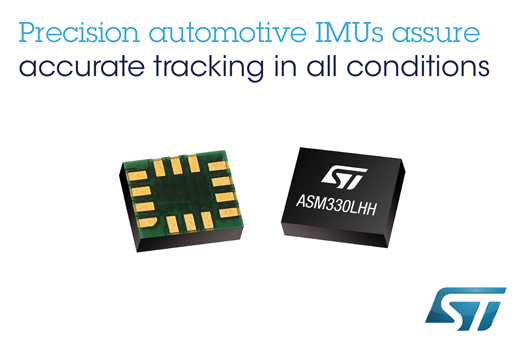By Brian Santo, contributing writer
Anticipating that vehicle navigation systems could get far more sophisticated to support safe semi-autonomous and fully autonomous driving, STMicroelectronics Inc. announced a high-performance 6-axis inertial sensor for the automotive market. Thales, meanwhile, introduced a new 6-axis inertial motion sensor for a set of other high-performance applications that include drone navigation, robotic control, camera/antenna platform stabilization, and augmented/virtual reality (AR/VR). These devices are more properly described as a 3-axis accelerometer combined with a 3-axis angular-rate sensor (essentially a gyroscope).
The automotive market has been using a variety of motion sensors for some time now but almost never for navigation. They’ve been used for things such as airbag deployment systems, which are triggered by simple 1- or 2-axis detectors that are more than adequate to sense the abrupt deceleration associated with collisions.
Autonomous vehicles will, of course, have on-board sensing. It looks likely that some, if not all, may end up also relying on GPS for geo-positional data. There is a growing expectation that, at least in cities, autonomous vehicles are likely to be connected to local 5G wireless networks that will exchange environmental data, which will be used by the vehicles’ navigation systems. But exactly how all semi-autonomous and autonomous vehicles will be equipped for safe navigation is still up in the air.
GPS cannot be relied on everywhere, including urban canyons, tunnels, covered roadways, parking garages, or dense forests, ST points out, which is one of the reasons why it is proposing the use of 6-axis motion sensors in combination with dead-reckoning algorithms to calculate precise position from sensor data should satellite signals be blocked. ST’s new ASM330LHH 6-axis inertial sensor will also enable telematics services such as e-tolling, tele-diagnostics, and e-call assistance.
The company claims that the forthcoming ASM330LHH will have the lowest power consumption in its class with features for optimizing power management if battery operation comes into play. It is built using ST’s proprietary Thick Epitaxy Layer for Micro-gyroscopes and Accelerometers (ThELMA) MEMS process technology. The accelerometer can scale up to ±16 g, while the gyroscope has a range from ±125 to ±4,000 degrees per second (dps). ST said that the device will operate across a temperature range of −40°C to 105°C.

STMicroelectronic’s ASM330LHH 6-axis inertial sensor.
Engineering samples will be available for evaluation by Q3 2018, followed by volume in Q4. Budgetary pricing starts at $5.00 for orders of 1,000 pieces. Reference designs as well as ST’s Teseo satellite-positioning modules and related software are available. The dead-reckoning algorithm included with the Teseo III GNSS-receiver chipset already supports the ASM330LHH for autonomous navigation applications, said the company.
Separately, Thales announced a new version of its 6-axis motion detectors, which the company categorizes as inertial measurement units (IMUs). The new NavChip2 IMU comes in a small and easily mountable package (12.5 x 24.5 x 5.4 mm) and was designed to exhibit low power dissipation, which the company said makes it especially suitable for applications such as drone navigation, robotic control, camera/antenna platform stabilization, and AR/VR. Thales caters to the defense and aeronautics industries.
Thales describes the NavChip2 as a “very low-drift” IMU with an acceleration range of ±16 g and a full-scale angular rate of ±2,000 dps. The company claims that it exhibits “exceptionally quiet acceleration noise performance.” Power consumption is 135 mW. The temperature range is −40°C to 85°C. The NavChip2 unit price is $450 in small quantities. Evaluation units are available from stock.
Several other companies including InvenSense (owned by TDK since 2016) and NXP also compete in the 6-axis motion sensor market.
TDK InvenSense has a line of 6-axis sensors aimed at applications such as navigation, imaging, and augmented reality. It already has one such device, which, like ST, is aimed at the automotive market. The IAM-20680 6-axis MotionTracking device combines a 3-axis gyroscope and a 3-axis accelerometer in a 3 x 3 x 0.75-mm (16-pin LGA) package. As of this writing, the company’s website notes that the IAM-20680 is sampling. The MEMS inertial sensors can be used in several automotive subsystems, including navigation/dead reckoning, infotainment, telematics, advanced driver assistance systems (ADAS), theft detection, E-911 location, and driver-facing camera image stabilization.
The sensors that NXP Semiconductors currently has designated for the automotive market include 1- and 2-axis MEMS accelerometers used for traditional applications, which, beyond airbag systems, include electronic stability control, electric parking brake, and tilt-angle measurement solutions. NXP does offer 6-axis sensors. The company’s current list of applications for those include augmented reality, e-readers, medical applications, home appliances, portable navigation devices, smartphones, and tablets — but not vehicle navigation systems.
Advertisement
Learn more about Electronic Products Magazine





